David Bowie's Hairdresser Details Sex, Betrayal Behind Rise and Fall of Ziggy Stardust in New Memoir
Suzi Ronson was a 21-year-old stylist when a chance encounter with Bowie's mother changed her life. Now she's sharing her intimate Starman memories in a new memoir
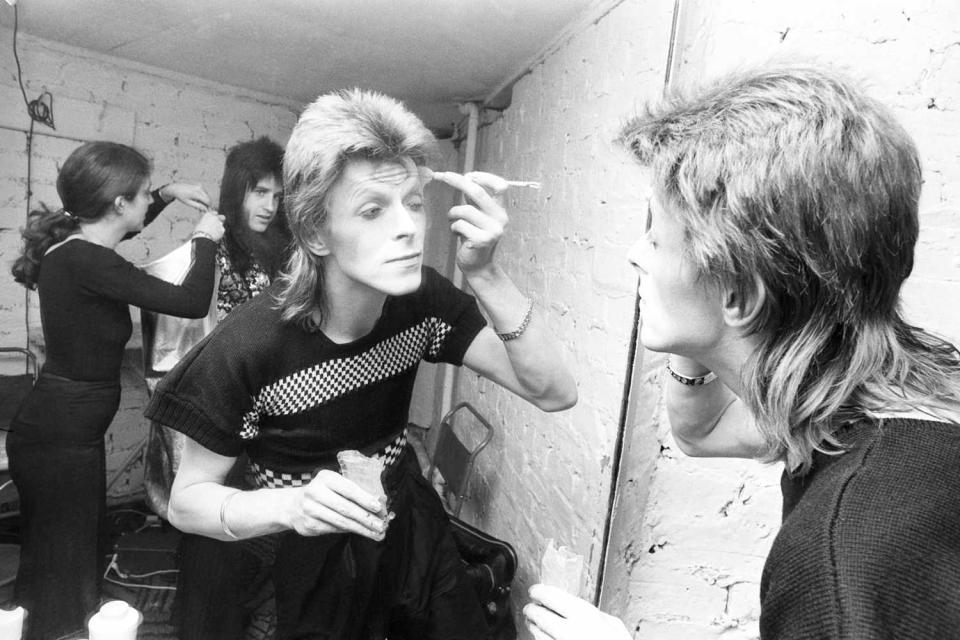
Roger Bamber/TopFoto
The year was 1971 and Suzi Ronson, 21, was a hairstylist working at a salon in the London suburb of Beckenham when one of the regulars came in for a perm. In her tweed skirt, knitted cardigan and sensible shoes, she seemed no different than the other “ladies of a certain age” who frequented the shop — at least as far as Ronson was concerned. Even her name sounded anonymous: Mrs. Peggy Jones.
Like most customers, Mrs. Jones began chatting about her family. She mentioned her “artistic” son David, proudly detailing all the musical instruments he’d mastered. “He was in the Top 10, you know,” she added. That got Ronson’s attention.
The David Mrs. Jones was bragging about was better known as David Bowie. At the time, he was little more than a one-hit-wonder, having gained notoriety with the pseudo-novelty song “Space Oddity” two years before.
Over the two years that followed, Bowie's Ziggy Stardust character would launch him into the pop culture stratosphere and Ronson was swept along as the hair and wardrobe specialist who helped develop Bowie’s otherworldly persona. She would accompany him on his first global tour, and bear witness to the corrosive effects of his rapid rise to fame and rampant sex and drugs.
Now Ronson is sharing her story in a new book, Me and Mr. Jones: My Life with David Bowie and the Spiders from Mars, out now from Simon & Schuster, which captures the thrilling era when the rock ‘n’ roll starman took flight — and the moment those in his orbit crashed back to Earth.
The birth of the Starman
Ronson saw Bowie long before she met him. He was a local celebrity in Beckenham, known less for his music than for his flamboyant style. The townsfolk never quite got used to the sight of Bowie and his wife Angie strolling down the sidewalk — he in a flowing gold maxi dress (later seen on the cover of The Man Who Sold the World) and she in jeans and a fur coat. Homosexuality had only recently been decriminalized, and gender nonconforming attire was far from commonplace on suburban streets.
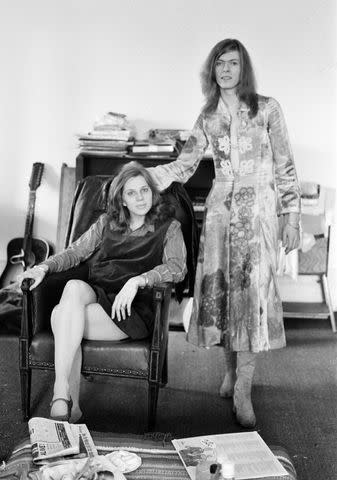
Daily Mirror/Mirrorpix/Mirrorpix via Getty
David Bowie and wife Angie at home in Haddon Hall, 1971Angie, a brash American actress who’d been married to Bowie for less than a year, sought Ronson out first. In search of a new “outrageous” hairstyle, she booked an appointment on Mrs. Jones’ recommendation.
Angie invited her to their home at Haddon Hall, a delightfully dilapidated Victorian mansion where the couple rented a flat. The expansive main hall, with its scented candles, stained glass windows and deep pile carpets, reminded Ronson of a decidedly funky church. As the threesome thumbed through expensive foreign magazines for style inspiration, they were drawn to a fashion spread by Japanese designer Kansai Yamamoto.
Bowie asked Ronson to copy the model’s short, red spiky hair. After some skilled scissor work and a liberal dose of “Red Hot Red” hair dye, Ziggy Stardust was born.
From that moment on, Ronson became the official hair and makeup expert to Bowie and his laddish “Spiders from Mars” bandmates who also resided at Haddon Hall: bassist Trevor Bolder, drummer Mick “Woody” Woodmansey and a handsome hotshot guitarist named Mick Ronson (who Ronson would later marry).
Close encounters with free love
“My life was all black and white until I met David,” Ronson writes, “and afterwards it was glorious technicolor, as bright as the hair on his head.” She discovered quickly that Bowie and Angie had an open marriage, and soon his attention turned to her.
When Bowie invited her to Haddon Hall one night, Ronson assumed he wanted a haircut. Instead, he had something different in mind: dinner together. Alone. “Tonight I meet a different David, charming and sweet, and before I know it his arm is around my waist and we’re out the door, in his car and on our way to London,” she writes. ”It’s easier going than I think; David seems interested in what I have
to say and he puts me at ease.”
Arriving back at Haddon Hall, Bowie propositions her in the driveway. “He turns to me as the car engine goes silent, and we sit in the dark until he says: ‘Well, Suzi, are you coming in?’ I know, I could get in my car and go home, but part of me is curious. I’m not that attracted to him, but as he holds my eyes, the distance between us closes and suddenly he’s kissing me. It’s a rush, the passion rises, and before I know what I’m doing I’m in the house and in his bedroom.”
The lusty moment cooled somewhat when Bowie mentioned how much fun he’ll have telling his wife about the encounter the next day. Ronson is horrified. “Shame washes over me,” Ronson writes, “How can I face Angie? ‘She’ll understand,’ he says, seeing my reaction. ‘She expects it – we have an understanding; it’d be worse if I didn’t tell her.’” Bowie assures her that they often compare notes about their latest conquests. “I hope I get a good report,” adds Ronson.
On tour with the Spiders from Mars
Angie persuaded Bowie's manager to hire her to accompany the band during the global trek in June 1972 to promote their latest album, Ziggy Stardust and the Spiders from Mars. While ostensibly Bowie’s stylist, the role went far beyond hairdressing. Ronson was tasked with dyeing the jockstrap for his stage outfit red and ironing out the sweat from his costumes. When Bowie stepped offstage, she was expected to wait in the wings with a glass of red wine and his favorite Gitanes cigarettes in hand.
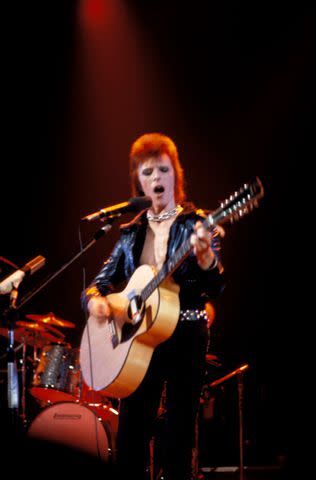
John Lynn Kirk/Redferns
David Bowie onstage in September 1972One of her less-than-savory duties was “tour madame,” choosing which fans to invite onto the bus or back to the hotel for intimate encounters with Bowie. Girls or boys, it didn’t matter. The only prerequisite was that they were beautiful and young. The latter point caused a problem one night after a concert in Birmingham, when Bowie retired to his suite with a female fan. A short time later, her irate mother appeared at the front desk, “kicking up a hell of a fuss,” Ronson writes. She refused to leave without her daughter — who, it turned out, was only 16. This was news to Ronson, who immediately rushed to Bowie’s room.
The young woman was “instantly deposited out of the door,” with a kiss from Bowie and a request to return the following year. “I calmed her down as she sobbed about how much she loved David and I promised her I’d get her tickets to any gig she wanted,” Ronson writes. “It was a close call. 'I wondered if I should start asking for proof of age before they got on the bus.”
At another gig, Ronson says she was asked to bring an “adorable-looking boy with an angelic face and long, dark curly hair” whom Bowie had spotted in the crowd back to his limo. She was shocked when Bowie didn’t even wait to get back to the privacy of the hotel before beginning the dalliance. “David threw himself into the car and without a word launched himself at the boy,” she writes. “I could see David pushing his tongue down the boy’s throat and his hand trying to open his trousers, all the while telling him what they’ll be doing back at the hotel. I was speechless.”
The dark side of David's fame
Once Bowie became the most successful act in Britain since the Beatles, Ronson noticed a change in him. “He blamed [disloyalty and] cocaine for his bad behavior. I laugh when I
read this and don’t believe it for a second,” she writes. “It was raw, naked ambition and a bloody-mindedness that is particular to a few people…It was revenge and control.”
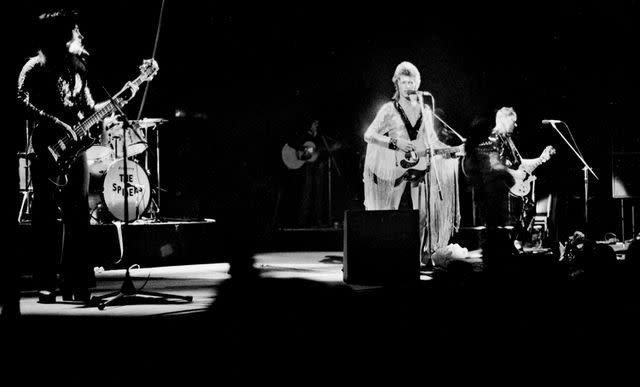
Gijsbert Hanekroot/Redferns
David Bowie backed by his band, the Spiders from Mars.While Bowie enjoyed all the financial perks of a rock star lifestyle, his band was scraping by on a minimum wage salary. This struck Ronson as deeply unfair, especially when it came to her future husband Mick Ronson, who was hugely influential in Bowie’s artistic development and played a crucial role in arranging his songs.
When bassist Trevor Bolder and drummer Woody Woodmansey began to mutiny due to their low wages, Bowie took this as the ultimate betrayal and began to ice them out. By the end of the tour, he’d decided to split the band. While Suzi Ronson was given a heads up, the rhythm section wouldn’t find out until they were onstage at what would prove to be their last gig.
It was July 3, 1973 at London’s Hammersmith Odeon. Ronson was in the wings when she heard Bowie announce to the crowd, “Not only is it the last show of the tour, but it’s the last show that we’ll ever do.”
As shockwaves rippled through the rock world, Bowie clarified in the press that his surprise retirement only applied to the Ziggy Stardust character. While he would go on to tour again and make more music, he'd be leaving the Spiders from Mars behind. Ronson says she never saw him or Angie again after the farewell gig at the Odeon. “I had thought we were closer than that. I really had.”
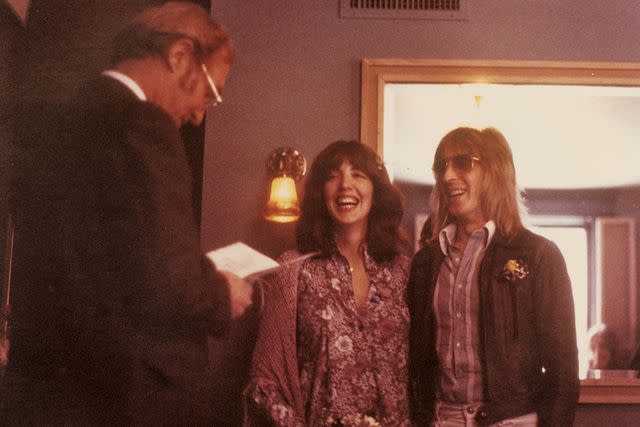
Courtesy of Suzi Ronson
Suzi and Mick Ronson on their wedding dayShe married Mick Ronson in 1977, shortly before the birth of daughter Lisa Anabelle. They remained together until 1993, when Mick died of liver cancer at 46. The same disease would claim Bowie’s life in 2016. “I wondered briefly if David thought about Mick at all during his struggle,” she recalled of hearing the news. Though it had been more than 40 years since they shared a room, the loss was potent. “I always hoped to see him one more time.”
Me and Mr. Jones: My Life with David Bowie and the Spiders from Mars by Suzi Ronson is out now from Simon & Schuster.
For more People news, make sure to sign up for our newsletter!
Read the original article on People.


